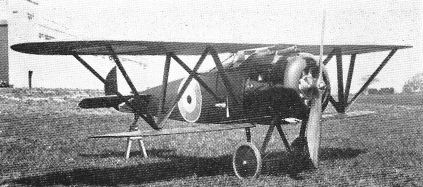The Spider was described as a delight to fly, the controls were powerful and harmonised making the little fighter extremely manoeuvrable. The Avro 531 Spider at The School of Special Flying at Gosport in 1918 where distinguished pilots of the period were allowed to fly the fighter during April and May and again in July.
DEVELOPMENT
The 531 Spider was an unprompted design which Avro had clearly put great faith in being ordered in significant numbers to replace the single-seat 504K night fighters that were serving with Home Defence squadrons at the time.
DESIGN
The private venture Spider was a single-seat fighter that used a large number of 504K components to speed up the manufacture of the new aircraft. A conventionally built, shorter fuselage was joined to the forward fuselage of a 504K while power was initially provided by an 110hp Le Rhone. Another practical feature of the little fighter was the rigging, which dispensed with the traditional wires and replaced them with steel Warren girder interplane struts/bracing. This was made up of six faired steel tubes which were arranged in three upside-down triangles on each side. These were attached to the lower spar of the lower mainplane and the twin main spars of the upper mainplane. The lower wing of the Spider was much shorter than the upper and only had a chord of 2ft 6in.
The pilot enjoyed a good field of vision despite the upper mainplane being fitted so close to the top of the fuselage. This was achieved by cutting a large circular aperture in the upper mainplane through which the pilot’s head protruded. The Spider was armed with a single synchronised .303in Vickers which was mounted slightly off-centre to starboard on top of the forward fuselage.
An extensively modified version of the Spider was designated as the 531A. This machine featured heavily staggered wire-braced mainplanes and 504K interplane struts. Power was provided by a 130hp Clerget and construction was believed to have begun in early 1919. The aircraft never came to fruition but it is presumed that the 531A’s major incomplete components where incorporated in the civilian Avro 538.
SERVICE
First flown in April 1918, the Spider was an instant favourite with all who were lucky enough to fly it. The fighter handled beautifully and with plenty of power in hand, the harmonised controls made the aircraft very manoeuvrable. During early flight trials the Spider was further improved when a 130hp Clerget was fitted and plans were also made to use a 150hp Bentley B. R. I and a 170hp A. B. C. Wasp I.
Between April 27 and May 18, 1918 the Spider was detached to the School of Special Flying at Gosport and during this time experienced pilots of the day were invited to fly the aircraft. The Spider returned to Gosport again on July 13 and continued to cause quite a stir with RFC pilots to such an extent, the Air Ministry could not fail to hear about the new Avro fighter.
Regardless of the enthusiasm being shown for the Spider, the Air Ministry had already selected the Sopwith Snipe as the RAF’s new standard single-seat fighter. Only one Spider was destined to be built and this remained in use as an experimental aircraft until at least the summer of 1919.
TECHNICAL DATA – AVRO 531 SPIDER
ENGINE: (531) One 110hp Le Rhône or 130hp Clerget; (531A) One 130hp Clerget
WING SPAN: (531 upper) 28ft 6in; (531A upper)
28ft; (531 lower) 21ft 6in; (531A lower) 27ft
LENGTH: 20ft 6in
HEIGHT: (531) 7ft 10in; (531A) 8ft 6in
WING AREA: (531) 189 sq ft
TARE WEIGHT: (531) 963lb; (531A) 960lb
ALL-UP WEIGHT: (531) 1,517lb; (531A) 1,514lb
MAX SPEED: 120mph
CLIMB RATE: 5,000ft in 4 mins
SERVICE CEILING: 19,000ft
ENDURANCE: (531A) 3 hours
